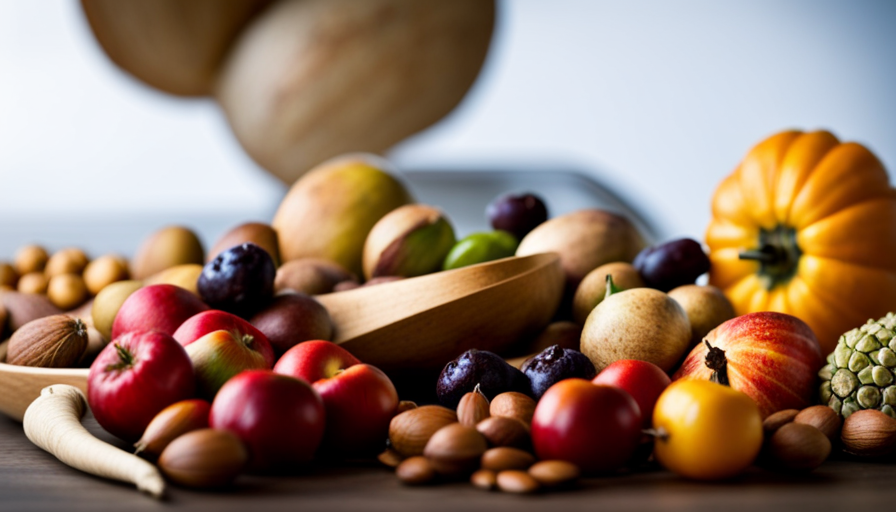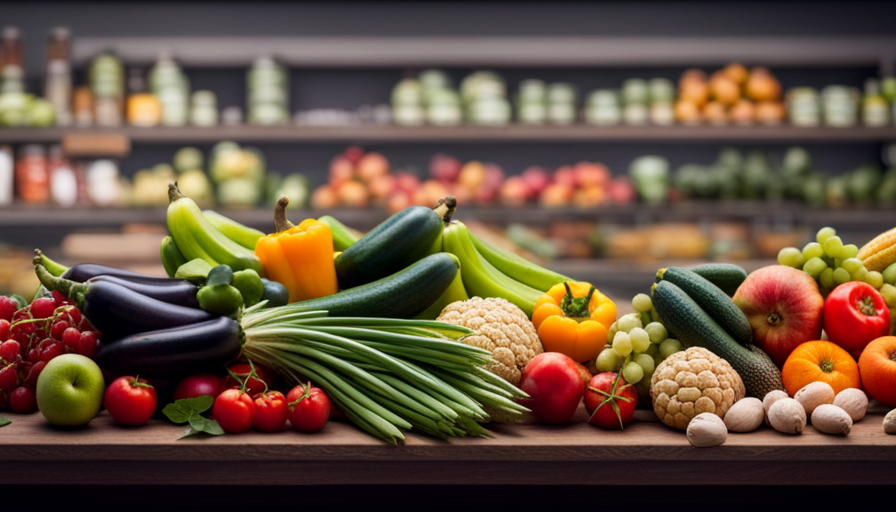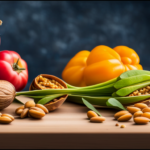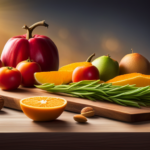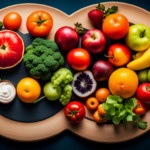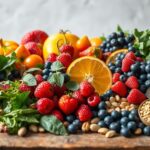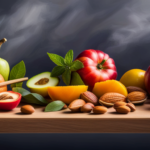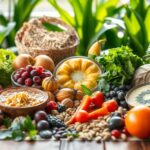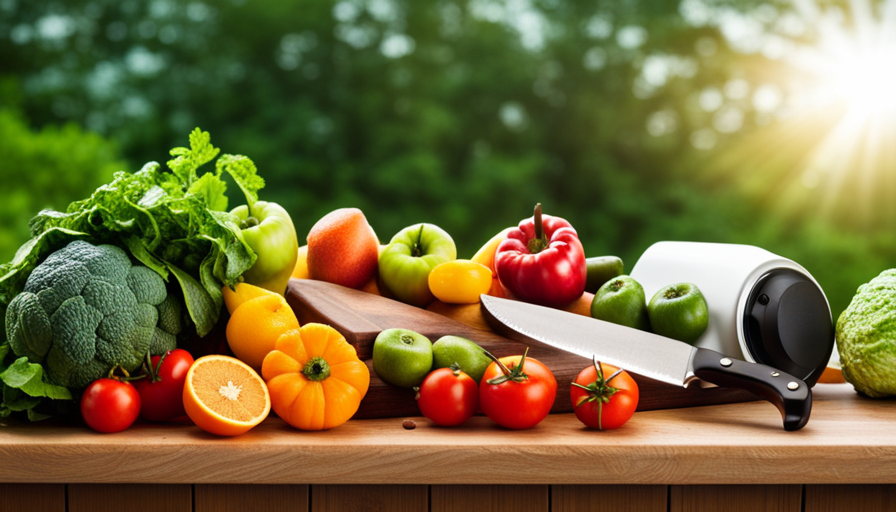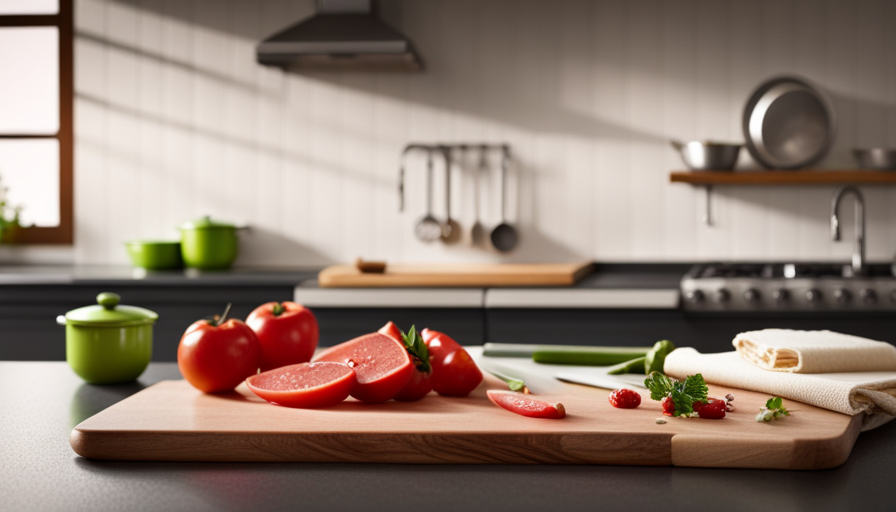In recent years, the raw food diet has been increasing in popularity. A survey conducted in 2019 revealed that 5% of Americans are adopting a raw food diet to enhance their health and overall well-being.
So, what exactly does this diet consist of? The raw food diet is centered around consuming unprocessed and uncooked foods, primarily fruits, vegetables, nuts, and seeds. It also includes sprouted grains and legumes, raw dairy and fermented foods, superfoods and supplements, as well as raw desserts and snacks.
Meal planning and preparation are essential in order to ensure a balanced and nutritious diet. However, there are also challenges that come with this lifestyle, such as the need for careful food handling and potential nutrient deficiencies.
Despite these challenges, many individuals who follow the raw food diet report long-term benefits, including increased energy levels, improved digestion, and weight loss. If you are considering adopting this diet, it is important to consider the lifestyle changes it may require and consult with a healthcare professional to ensure it meets your nutritional needs.
Key Takeaways
- The raw food diet consists of unprocessed and uncooked foods such as fruits, vegetables, nuts, seeds, sprouted grains, legumes, raw dairy, fermented foods, superfoods, and supplements.
- Meal planning and preparation are essential for a balanced raw food diet.
- Raw fruits and vegetables are packed with essential vitamins, minerals, antioxidants, dietary fiber, and water content.
- Nuts and seeds provide protein, healthy fats, fiber, vitamins, and minerals, and add crunch and texture to raw food dishes.
Fruits and Vegetables
Now, let’s talk about the fruits and veggies you’ll be munching on in your raw food diet! Fruits and vegetables are the backbone of this diet, and for good reason. Raw produce is packed with essential vitamins, minerals, and antioxidants that are crucial for optimal health.
Not only do fruits and vegetables provide a wide range of nutrients, but they also offer numerous health benefits. Including a variety of fruits in your raw food diet ensures that you get a diverse range of vitamins and minerals. For example, citrus fruits like oranges and grapefruits are rich in vitamin C, which boosts your immune system and helps fight off infections. Leafy greens like spinach and kale are packed with iron and calcium, which are essential for maintaining healthy bones and preventing anemia.
In addition to their nutrient content, fruits and vegetables are also rich in dietary fiber. This fiber aids digestion, helps regulate blood sugar levels, and keeps you feeling full and satisfied. The high water content in fruits and vegetables also helps to hydrate your body and support healthy digestion.
Transitioning to the next section about nuts and seeds, it’s important to note that these plant-based foods provide a variety of essential nutrients that complement the benefits of fruits and vegetables.
Nuts and Seeds
To fully embrace the raw food lifestyle, you’ll find that nuts and seeds become your loyal allies, sprinkling a trail of health and vitality throughout your culinary journey. Nuts and seeds are an essential component of a raw food diet, providing a wealth of nutrients and benefits.
These tiny powerhouses are packed with protein, healthy fats, fiber, vitamins, and minerals. Incorporating nuts and seeds into your daily meals can help to maintain a balanced and nutritious diet.
One of the benefits of incorporating nuts and seeds into a raw food diet is their high nutrient content. For example, almonds are rich in vitamin E, magnesium, and calcium. Walnuts are a great source of omega-3 fatty acids, which are beneficial for heart health. Chia seeds are packed with omega-3s, fiber, and antioxidants. Flaxseeds are another excellent source of omega-3s and fiber.
In addition to their nutrient density, nuts and seeds also provide a satisfying crunch and texture to raw food dishes. They can be sprinkled on top of salads, blended into smoothies, or used as a base for raw desserts. Furthermore, they add a delicious and creamy texture when soaked and blended into nut or seed butters.
Now, let’s move on to the next section about sprouted grains and legumes, where we will explore the benefits of including these nutritious foods in a raw food diet.
Sprouted Grains and Legumes
Sprouted grains and legumes are bursting with nutrients and hold the key to unlocking a whole new level of vitality in your meals. These foods are incredibly nutritious and offer a range of health benefits.
When grains and legumes are sprouted, their nutrient content increases dramatically. Sprouting breaks down the starches and makes the nutrients more bioavailable, allowing our bodies to absorb them more easily. This process also increases the content of vitamins, minerals, and antioxidants in these foods.
Sprouted grains and legumes are rich in fiber, which aids in digestion and helps maintain a healthy weight. They also provide essential amino acids, the building blocks of protein, making them an excellent plant-based protein source for vegetarians and vegans. Additionally, sprouting can reduce the levels of anti-nutrients, such as phytic acid, which can interfere with mineral absorption.
To prepare sprouted grains and legumes, you can soak them in water for a few hours or overnight until they begin to sprout. Then, rinse and drain them thoroughly before incorporating them into your recipes. You can add sprouted grains to salads, stir-fries, or use them as a base for grain bowls. Sprouted legumes can be used in soups, stews, or mashed into spreads like hummus.
Sprouted grains and legumes provide a nutritious foundation for your raw food diet. Transitioning to the next section about raw dairy and fermented foods, we can explore how these foods can further enhance your health and well-being.
Raw Dairy and Fermented Foods
Raw dairy products offer numerous benefits in a raw food diet. They are not only a rich source of essential nutrients like calcium, protein, and vitamins, but they also contain enzymes and beneficial bacteria that aid in digestion.
Additionally, fermented foods play a crucial role in a raw food diet. They are teeming with probiotics that support gut health and boost the immune system.
Exploring the benefits of raw dairy products
Consuming raw dairy products offers a plethora of advantages, such as boosting the immune system and improving digestion. Raw dairy products are packed with essential nutrients, including vitamins, minerals, and enzymes that are often destroyed during pasteurization. They also contain beneficial bacteria and probiotics that support gut health and enhance the immune system. Additionally, raw dairy products are easier to digest compared to their pasteurized counterparts, as the enzymes present in raw milk aid in breaking down lactose.
To further illustrate the benefits, consider the following table:
| Benefits of Raw Dairy Products | |
|---|---|
| Boosts immune system | Improves digestion |
| Rich in nutrients | Supports gut health |
| Contains beneficial bacteria | Easy to digest |
Exploring the benefits of raw dairy products is just the beginning. In the next section, we will delve into the introduction to fermented foods and their role in a raw food diet.
Introduction to fermented foods and their role in a raw food diet
Get ready to discover the incredible world of fermented foods and how they can play a vital role in your journey towards a healthier you!
Fermented foods are a key component of a raw food diet, as they provide a rich source of probiotics. Probiotics are beneficial bacteria that promote a healthy gut. They help to maintain a balanced digestive system, improve nutrient absorption, and boost the immune system.
Some popular fermented foods include sauerkraut, kimchi, kefir, and kombucha. These foods go through a natural fermentation process, where the sugars and carbohydrates in the food are broken down by bacteria and yeast. This process not only enhances the flavor and texture of the food but also increases its nutritional value.
As we delve into the next section about superfoods and supplements, we will explore how these fermented foods can be combined with other powerful ingredients to further enhance your well-being.
Superfoods and Supplements
You’ll find an abundance of nourishing superfoods and supplements in the raw food diet that can powerfully promote your health. Superfoods are nutrient-dense foods that provide a wide range of vitamins, minerals, antioxidants, and other beneficial compounds. Incorporating superfood recipes into your raw food diet can enhance its nutritional value and flavor.
Some popular superfoods include chia seeds, goji berries, spirulina, and maca powder. These ingredients can be added to smoothies, salads, or raw desserts to boost their health benefits.
Supplements, on the other hand, are concentrated forms of nutrients that can be taken in addition to a balanced diet. While it’s important to obtain nutrients from whole foods, supplements can be helpful in filling any nutritional gaps.
Some common supplements used in a raw food diet include vitamin B12, omega-3 fatty acids, and probiotics. These supplements can support energy levels, brain function, and gut health.
By incorporating superfoods and supplements into your raw food diet, you can optimize your nutrient intake and support your overall well-being. These additions can provide an extra boost of vitamins, minerals, and other beneficial compounds that may be lacking in a solely plant-based diet.
Moving forward, let’s explore the benefits of juicing and smoothies in the raw food diet.
Juicing and Smoothies
Blend your favorite fruits and vegetables together to create vibrant and refreshing juices and smoothies that burst with flavor and nourishment. Juicing and smoothies are a popular way to incorporate raw foods into your diet. Here are three benefits of juicing:
-
Increased nutrient absorption: When you juice fruits and vegetables, you remove the indigestible fiber, allowing your body to quickly absorb the vitamins, minerals, and antioxidants. This can result in a quick nutrient boost.
-
Hydration: Juices and smoothies are a delicious way to stay hydrated, especially during hot summer months. They can help replenish electrolytes and provide a natural source of hydration.
-
Detoxification: Many fruits and vegetables used in juicing have detoxifying properties. They can help cleanse your body by eliminating toxins and promoting healthy digestion.
Now, let’s talk about smoothie recipes. Smoothies are a thicker blend of fruits, vegetables, and other ingredients. They’re a great option for a quick and nutritious meal or snack. You can customize your smoothie by adding ingredients like Greek yogurt, nut butter, or chia seeds for added protein and healthy fats. Smoothies are also a fantastic way to incorporate leafy greens, such as spinach or kale, into your diet.
As we move on to the next section about raw desserts and snacks, you’ll discover delicious and healthy treats that’ll satisfy your sweet tooth without compromising your raw food lifestyle.
Raw Desserts and Snacks
Indulge in delectable treats that’ll satisfy your sweet tooth and tantalize your taste buds, all while staying true to the raw food lifestyle.
Raw desserts and snacks offer a wide range of options that aren’t only delicious but also packed with nutrients.
One popular choice is raw energy balls, made from a blend of nuts, dates, and other ingredients. These bite-sized snacks are perfect for a quick pick-me-up during the day.
Another delightful option is raw chocolate avocado mousse, which combines the creaminess of avocados with the richness of raw cacao powder.
When it comes to healthy desserts, raw food enthusiasts can enjoy raw fruit tarts made with a nut-based crust and topped with fresh fruits.
Raw cheesecakes are also a hit, using cashews and coconut milk for a creamy texture.
For a refreshing treat, raw fruit sorbets made with frozen fruits are a great choice.
Incorporating raw snacks and desserts into your raw food diet adds variety and satisfies cravings without compromising on nutrition.
These guilt-free indulgences prove that eating raw doesn’t mean sacrificing taste.
So, make sure to include these delightful treats in your meal planning and preparation for a well-rounded raw food experience.
Meal Planning and Preparation
When it comes to meal planning on a raw food diet, I’ve found a few helpful tips.
First, I like to make a weekly meal plan and grocery list to make sure I have all the necessary ingredients on hand.
Second, I find it helpful to prep and chop my fruits and vegetables ahead of time, so they’re ready to go when I want to make a meal.
Lastly, I like to batch cook certain raw dishes, like soups or sauces, and freeze them in individual portions for quick and easy meals.
These time-saving techniques have made it much easier for me to stick to my raw food diet.
Tips for meal planning on a raw food diet
To effectively plan your meals on a raw food diet, you can easily incorporate a variety of fresh fruits and vegetables into your daily routine, giving you a taste of the rainbow and ensuring you’re getting a healthy dose of nutrients.
When it comes to meal planning tips for a raw food diet, it’s important to consider the different food groups and balance your meals accordingly. Include a mix of fruits, vegetables, nuts, and seeds to ensure you’re getting a good variety of nutrients.
Additionally, try to plan your meals ahead of time to avoid impulsive food choices and to ensure you have all the necessary ingredients on hand.
Lastly, consider experimenting with different recipes and flavors to keep your meals exciting and enjoyable. By following these meal planning tips, you can easily stick to your raw food diet and reap the many health benefits it offers.
Now, let’s move on to time-saving techniques for preparing raw meals.
Time-saving techniques for preparing raw meals
Make the most of your time by utilizing efficient techniques for preparing raw meals. When it comes to saving time on meal preparation, there are several strategies you can employ.
One time-saving technique is to batch prep your ingredients. This means chopping, slicing, and prepping all your fruits and vegetables in one go, so they’re ready to use throughout the week.
Another helpful tip is to invest in time-saving kitchen tools like a high-speed blender or a food processor. These appliances can make quick work of blending, chopping, and pureeing ingredients.
Additionally, consider making use of overnight soaking and sprouting techniques for certain foods like nuts, seeds, and legumes, as this can reduce the overall preparation time.
By implementing these time-saving techniques, you can streamline your raw meal preparation process and make it more efficient.
As we move into the next section about challenges and solutions, it’s important to keep in mind that time management is crucial when following a raw food diet.
Challenges and Solutions
One of the challenges you’ll face on the raw food diet is finding creative and satisfying alternatives to cooked meals, but with determination and resourcefulness, you can discover delicious ways to enjoy your food without compromising on nutrition. One common challenge is the perception that raw food diets are boring or tasteless. However, there are numerous solutions to overcome this challenge, such as experimenting with different flavor combinations, using spices and herbs to enhance taste, and exploring new recipes and techniques.
Another challenge is the time and effort required for food preparation. To address this, there are time-saving techniques you can employ, like batch prepping and meal planning. By spending a few hours on the weekend to prepare ingredients and meals for the week ahead, you can save time and ensure that you have nutritious meals readily available. Additionally, investing in time-saving kitchen tools like a high-speed blender or food processor can greatly simplify the process of preparing raw meals.
To further illustrate the challenges and solutions on the raw food diet, consider the following table:
| Challenge | Solution |
|---|---|
| Lack of variety in raw food options | Experiment with different flavors and recipes |
| Time-consuming food preparation | Use batch prepping and meal planning |
| Perceived boredom or lack of taste | Incorporate spices, herbs, and creative techniques |
By addressing these challenges and implementing the suggested solutions, you can make the raw food diet more enjoyable and sustainable in the long term. Transitioning to the subsequent section about ‘long-term benefits and lifestyle considerations’, it’s important to understand the positive impact that the raw food diet can have on your overall well-being.
Long-Term Benefits and Lifestyle Considerations
When considering the potential long-term health benefits of a raw food diet, it’s important to understand that this way of eating can provide a high intake of vitamins, minerals, and antioxidants.
These nutrients are essential for maintaining optimal health and can support a strong immune system and vibrant overall well-being.
Additionally, incorporating the principles of a raw food diet into your overall lifestyle can promote mindful eating, encourage increased consumption of fruits and vegetables, and potentially lead to weight loss and improved digestion.
Potential long-term health benefits of a raw food diet
Explore the potential long-term health benefits of embracing a raw food diet – it’s an exciting journey that can revolutionize your well-being.
One of the main advantages of a raw food diet is the potential for weight loss. Raw foods are typically lower in calories and higher in fiber compared to processed and cooked foods, which can lead to a reduction in overall calorie intake.
Additionally, raw foods are rich in enzymes that aid in digestion and can improve gut health. These enzymes help break down food more efficiently, reducing bloating and discomfort.
Furthermore, a raw food diet is abundant in vitamins, minerals, and antioxidants, which can support overall health and reduce the risk of chronic diseases.
By incorporating the principles of a raw food diet into your overall lifestyle, you can create a foundation for optimal well-being.
Incorporating the principles of a raw food diet into your overall lifestyle
Transform your overall lifestyle by embracing the principles of a raw food diet and watch as your well-being flourishes. Incorporating the principles of a raw food diet into your daily routine can be a rewarding experience.
Here are four ways to transition to a raw food lifestyle:
-
Start slowly: Gradually introduce more raw fruits, vegetables, nuts, and seeds into your meals while reducing processed and cooked foods.
-
Experiment with recipes: Explore the abundance of raw food recipes available online and in cookbooks to broaden your culinary horizons.
-
Plan your meals: Make a meal plan and prep your ingredients in advance to ensure you have a variety of raw options readily available.
-
Stay hydrated: Drinking plenty of water and incorporating hydrating raw foods like cucumbers and watermelon can help maintain optimal hydration levels.
Incorporating these principles into your lifestyle can lead to increased energy, improved digestion, and enhanced overall health.
Frequently Asked Questions
Can I still eat cooked food while following a raw food diet?
Yes, you can still eat cooked food while following a raw food diet, but it’s important to focus on incorporating cooked food alternatives that align with the principles of this diet. The raw food diet emphasizes consuming unprocessed, uncooked plant-based foods, such as fruits, vegetables, nuts, and seeds.
However, lightly steaming or sautéing vegetables, baking or grilling fruits, or making raw food desserts with ingredients like dates and nuts are all considered acceptable alternatives. This allows for a variety of flavors and textures while still reaping the benefits of a raw food diet.
Is it necessary to eat organic fruits and vegetables on a raw food diet?
Yes, it’s absolutely essential to eat organic fruits and vegetables on a raw food diet! The benefits of organic produce are simply mind-blowing. Not only does it contain higher levels of nutrients, antioxidants, and flavor, but it also reduces the intake of harmful pesticides and chemicals.
Now, I know some people worry about the cost, but trust me, the long-term health benefits far outweigh any initial expenses. So, go ahead and treat yourself to the best nature has to offer!
How do I ensure I am getting enough protein on a raw food diet?
To ensure I’m getting enough protein on a raw food diet, I can incorporate alternative protein sources like nuts, seeds, and legumes. Nuts such as almonds and cashews are rich in protein and healthy fats.
Seeds like chia and hemp seeds also provide a good amount of protein.
Legumes like chickpeas and lentils are excellent sources too.
Including these foods in my meals will help me meet my protein needs while following a raw food diet.
Are there any potential risks or side effects of following a raw food diet?
Following a raw food diet can lead to potential health risks and nutrient deficiencies. This diet mainly consists of uncooked fruits, vegetables, nuts, and seeds, which poses a risk of bacterial contamination. Additionally, cooking helps break down certain nutrients, so a raw food diet may result in deficiencies in vitamins B12, iron, calcium, and omega-3 fatty acids. It’s important to carefully plan and monitor your nutrient intake to avoid these potential issues.
Can I still enjoy social gatherings and eat out while following a raw food diet?
While following a raw food diet, I can still enjoy socializing and dining out. Many restaurants offer raw food options or are willing to accommodate dietary restrictions. I can choose salads, vegetable-based dishes, or fruit platters. It’s important to communicate my dietary needs to the restaurant staff and ask for modifications if needed.
Additionally, I can bring raw snacks or dishes to social gatherings to ensure I have something to eat that aligns with my diet.
What Are the Key Components of a Raw Food Diet?
The key components of a raw food diet revolve around consuming uncooked, unprocessed, and organic foods such as fruits, vegetables, nuts, seeds, and grains. While some people have positive opinions on raw food diets due to their health benefits and nutrient-rich content, others believe they may lack essential nutrients and pose potential health risks.
Conclusion
In conclusion, the raw food diet offers a tantalizing array of vibrant and nourishing options that can transform one’s health and well-being. By embracing the beauty of nature’s bounty, we can embark on a journey towards optimal nutrition and vitality.
Though challenges may arise along the way, the rewards are worth it. So let’s savor the crispness of fresh fruits, the richness of nuts and seeds, and the vitality of sprouted grains and legumes. Let’s indulge in the creamy delight of raw dairy and fermented foods, and explore the power of superfoods and supplements.
And when cravings strike, let’s delight in the guilt-free pleasure of raw desserts and snacks. With careful meal planning and preparation, we can navigate the path to a raw food lifestyle with ease. And as we continue on this journey, we’ll discover the long-term benefits and lifestyle considerations that come with it.
So let’s embrace the raw food diet and unlock the true potential of our bodies and minds.

